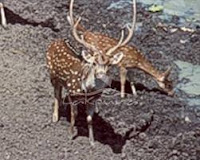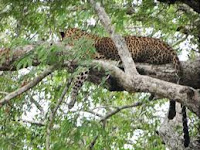Sri Lanka though small in size is one of the few places on earth where the world’s largest land and sea mammals can be seen in a day and features no fewer than nine national parks and seven bird sanctuaries. A wide range of native species such as elephants, leopard, sloth bear, a verity of deer, the purple faced leaf monkey, the wild boar, porcupines and ant-eaters. Reptiles include vipers and marsh and crocodiles. Among many endemic amphibians are the Nanophyrys frogs in the hills. Most of the trout fish introduced by the British are found in the cool streams of the Horton plains and river or marsh dwellings.
These "National Parks" are managed by Department of wildlife conservation and are open to visitors. In certain National Parks - Yala, Wilpattu, Wasgamuwa, Kumana, Udawalawe accommodation can be found within the park itself. Bungalows in these parks can be reserved through the Wild Life Department which is situated at Battaramulla, Colombo. The largest National Parks are Yala, Gal-oya, Uda Walawe, Wilpattu, Minneriya, Horton Plains and Wasgamuwa.
Yala National Park
Yala being the second largest national park in Sri Lanka is situated in the Southeast of the island in the dry, semi-arid climate region. This is the most visited Park in by tourists. The park covers 979 square kilometres (378 sq mi) and is located about 300 kilometres (190 mi) from Colombo. It borders the Indian Ocean. The terrain is varied flat plains alternating with rocky outcrops. The vegetation ranges from open park land to dense jungles. Water holes, streams, lakes, lagoons provide water to animals and birds. Yala has the highest number of leopard sightings with elephants and sloth bears.
 |
| Sloth Bear at Yala |
 |
| Dancing Peackock at Yala |
Wasgamuwa National Park
Wasgamuwa is one of the island’s protected areas abundant with large herds of elephant . Wasgamuwa National Park lies within the Polonnaruwa and Matale Districts and have the Mahaweli river and Amban river as its eastern and western boundaries. Wasgamuwa provides ample opportunities to view elephants, leopards, the sloth bear, sambhur, deer, wild buffalo. This covers an area of 370.629 km2.
 |
| Herd of Elephants at Wasgamuwa |
 |
| Deer at Wasgamuwa |
Minneriya National Park
Located between Habarana and Pollonnaruwa, Minneriya is another haven for the elephants who migrate from surrounding jungles to enjoy the grass fields on the banks of the Minneriya reservoir. This covers an area of 88.894 km2. Although the park itself doesn’t offer accommodation, excellent lodging can be found in the areas of Sigiriya and Habarana.
 | ||||||
| Herd of elephants near Minneriya tank |
Wilpattu National park
Wilpattu is situated in the Northwest coast, lowland, dry zone. One of the largest and oldest National Parks covering an area of 1,316.671 km2. Renowned for its its leopard sightings along with 31 species of mammals and an abundance of wetland bird species. It has a dense jungle cover which makes it a more exciting park where animals have to be tracked. There are numerous little lakes - known as villus - and the leopard and sloth bear are the specialty rather than elephants.
 | |
| Kokmute circuit bungalow inside Wilpattu |
 |
| Leopard on a tree after a good meal at Wilpattu |
Uda Walawe National Park
Udawalawe is a myriad of interesting flora and fauna due to the presence of the Udawalawe reservoir on the Walawe river. Area covered by this park is 308.21 km2.
This Park which lies within the Ratnapura and Monaragala Districts acts as the catchment to the Uda Walawe Reservoir and is located in the Dry Zone. This Park comprises grasslands and thorn scrubs and many valuable species of trees are found within it. Large herds of Elephants and Deer species such as spotted Deer, Sambhur, Barking deer and Langur, Wild Boar, Water Buffalo, Jackal are some of the prominent wild animals found in this Park and a variety of avifauna is seen.
 | |
| Herd of elephants at Udawalawe |
Kumana National Park
Situated on the border of the Yala National Park covering an area of 181.482 km2 is a well-known eco tourism attraction and bird sanctuary where a multitude of birds breed and roost.
A significant features of the park is the 'Kumana Villu' - a 200 hectare natural swamp lake, fed by the 'Kumbukkan Oya' through a half mile long narrow channel. It is at this mangrove swamp that many water birds nest in May and June. Regular sightings include such species of bird as pelicans, painted storks, spoonbills, white ibis, herons, egrets and little cormorants. The very rare black-necked stork, the lesser adjuant, Eurasian spoonbill and the great thick-knee.
 |
| Flemingos at the Kumana Park |
Horton Plains National Park
The Horton Plains National Park is the only National Park situated in the Hill Country and falls within the Nuwara Eliya district and is 200 km, covering an area of 31.598 km2. Home to more than half of Sri Lanka’s endemic flowering plants and more than endemic trees and shrubs, the Horton Plains is a mist shrouded and breathtaking wonder and ideal for trekking, hiking and camping. The famous `Worlds End' is a major attraction within the Park. Endemic slender loris and endemic purple monkey are among the important animal species that could be seen in addition if you are lucky one could enjoy the splendor of the leopard, the sambhur.
Pinnawala Elephant Orphanage
Abandoned elephants who cannot survive in the wild are given a home at the Elephant Farm at Pinnewela near Rambukkana.
Human foster parents feed groom and care for elephants in this elephant orphanage. Baby elephants were fed with milk from super-size bottles, seven times a day. The orphans arrive from across the country, rescued from remote villages where they have lost their families.
 |
| Feeding baby elephants at the orphanage |
 |
| Bathing elephants at Pinnawela |

